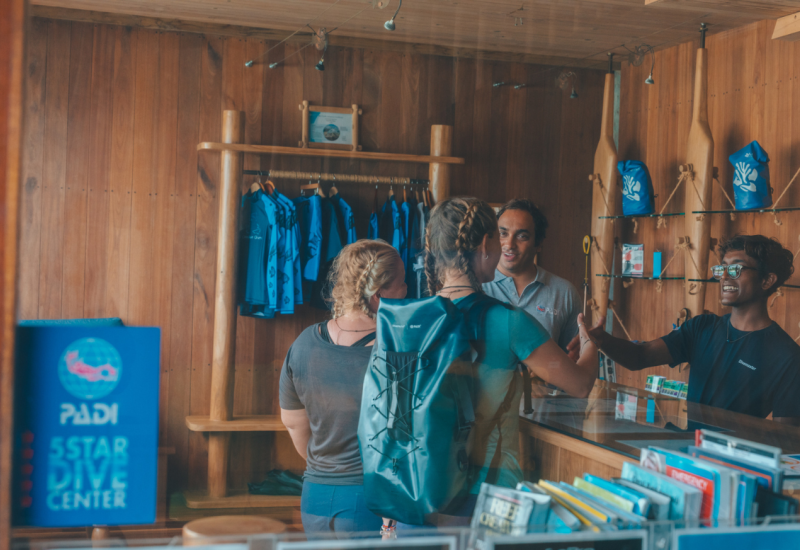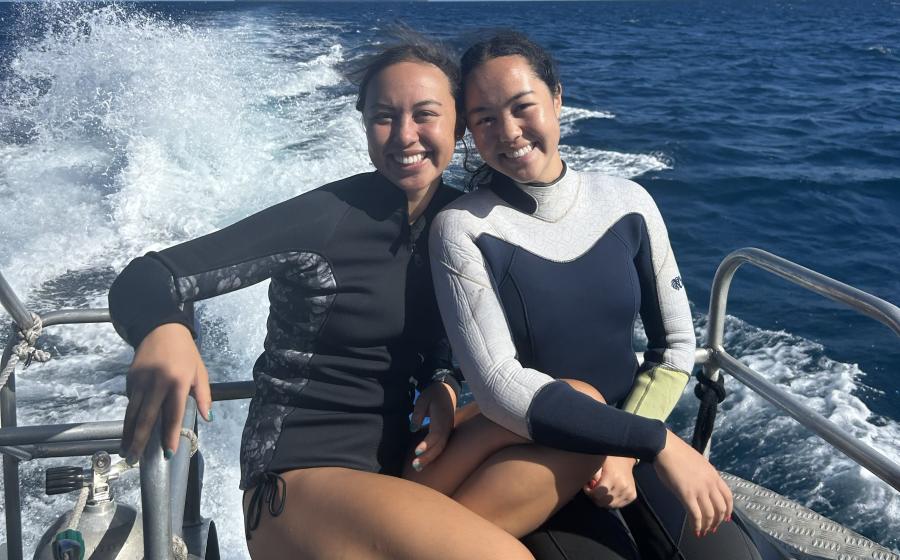Liveaboard: Palau Siren
Bucking at the end of a reef hook at Palau’s legendary Blue Corner might be diving’s most exciting thrill ride. From the deep ocean, a 3-knot river rushing up and over the wall tries to blow me away like a sadistic teenager spraying ants off a sidewalk with a garden hose. But this is far more fun, tethered to a bare spot on the hard-coral reef by a 6-foot length of nylon line, BC inflated for positive buoyancy and blasted by the brute power of the sea. And it’s not just the wild ride that makes this dive so pulse-pounding, it’s the view: a near-constant parade of predators.
54 ... 55 ... 56 ... 57 — I stop counting when the sheer number of sharks passing by reaches the level of ridiculous. And that’s not including the dogtooth tuna, big-eye jacks, midnight snapper and other predators, plus the smaller tropicals — scarlet soldierfish, black durgons and bright butterflyfish — that fill in the visual blanks between fins. Glancing over to my buddy, his strobes firing furiously at the scene, I laugh into my reg at the near-horizontal torrent of exhalation streaming from his face, as if blown through a child’s bubble wand. He’s clearly as stoked as I am by the show.
Twenty minutes earlier, we had descended into a dark hole in a shallow coral garden some distance up the reef at a site called Blue Holes. Inside the large cavern, which drops to around 120 feet, we searched for pulsing disco clams and black-coral trees before breaking out into the bright sunlight through a window at 45 feet to cruise along the wall toward Blue Corner, where we would hook onto the reef. That’s when the parade began.
Cruising lazily into the current slows down the normally swift-moving gray reef, blacktip and whitetip sharks enough to enable a close inspection — and a deeper appreciation — of their sleek design, smooth, matte skin and piercing white eyes. Periodically, individuals hang in front of me for minutes at a time. And I love every second of it.
Blue Corner is just one of the perception-changing dives that Palau can count as commonplace. Although this bevy of world-class sites is accessible by high-speed day boats, the absolute best way to experience the island nation’s underwater splendor is by live-aboard.
The Unfair Advantage
The Palau Siren, which began operating in the region in October 2012, is the newest live-aboard serving the Micronesian archipelago of more than 250 islands. It’s a traditional Indonesian Phinisi design, with graceful curves, a pair of tall masts rigged in bright blue sails and the romantic symphony that only a wooden vessel can orchestrate. At a length of 130 feet and with a wide beam of 30 feet, the yacht accommodates guests with its luxurious teak finishes, open-air ambience and ample space for everyone. Meals are served at an expansive U-shaped dining area on the breezy stern deck, and the dive deck at midship is equally user friendly, with plenty of personal space for gearing up, plus convenient storage for wetsuits and equipment.
The Siren’s dive operation benefits greatly from guides who come from the staff pool at Sam’s Tours, one of Palau’s longest-running operators, so they know when the best sites are prime and can show their divers the best of everything. Guests are chauffeured to dive sites in a pair of 30-foot fiberglass pangas, fully outfitted with ladders and large canopies, which increases the comfort level greatly. And they’re fast, which puts divers on Palau’s best sites well before the day boats from Koror have even left the dock. That’s one of the top benefits of a trip aboard the Siren — being the early bird. Because the captain can move the floating dive resort to the most advantageous moorings on a daily basis as determined by weather and tides, passengers are typically the first divers on the best sites each day. And that’s a very nice bonus, because Palau offers incredible variety to discerning divers of every breed.
Wreck lovers will discover an impressive amount of history on display beneath the surface of Palau’s waters. Near the end of World War II, the U.S. Navy struck a deadly blow to a group of Japanese warships hiding among the Rock Islands during Operation Desecrate One. The result is a ghost fleet of dozens of sunken vessels decorated with growth from more than six decades underwater. Most are massive hulks, heavily populated with marine life and loaded with compelling artifacts. A single dive on the famed Helmet Wreck yields massive sake bottles, gas masks, torn boots, used ordnance of varying calibers and much more, like a close-up encounter with a stealthy crocodilefish.
Jellyfish Lake is a signature Palau experience that’s a staple of the Siren itinerary. The isolated marine lake in the Rock Islands is world famous for the millions of virtually stingless golden jellies that thrive in the brackish water. Snorkeling in the dark water through throngs of gelatinous orbs is every bit as surreal as one would expect, and typically accompanied by a soundtrack of excited laughing from the other visitors.
Aside from the unique sites, WWII wrecks and other atypical attractions, Palau’s reefs deliver all of the South Pacific idyll that divers expect from the region. From the high-octane drift dives of Ulong Channel and Pelelui Express to the manta encounters at German Channel, and the plunging underwater cliffs at Ngemelis Wall and New Dropoff, the archipelago delivers big on the fantasy. Experiencing it all from the comfort and convenience of the Palau Siren seems like an unfair advantage — not that you’ll care.
Five Reasons to Dive Palau Aboard Palau Siren
1: Dawn Patrol
Palau’s best sites are scattered along a vast archipelago that day boats out of Koror reach in 30 to 45 minutes. Siren guests get there in a fraction of that time and are usually the first divers on the best sites each morning.
2. Prime Conditions
The Siren’s moveable underwater feast makes the most of weather and tides, ensuring the best conditions for the signature dive sites.
3. Variety
Palau’s bevy of world-class dive sites run the gamut from shallow coral gardens to plunging walls, caverns with wild features, current-swept channels and much more.
4. Wrecks
In March 1944, the U.S. Navy’s Operation Desecrate One sank 36 ships around Palau. Some of the best wreck dives include Bichu, Maru, Iro, Chuyo Maru and Jake Seaplane.
5. Pure Fantasy
One lazy gaze at the stunning 360-degree view of the gorgeous Rock Islands from a lounge on the Siren’s sun deck beneath the tall masts, and you’ll be asking for an employment application.
Need to Know
>>When to Go: Palau’s diving is good year-round; June to November is rainy season and January to May sees the biggest crowds.
>>Dive Conditions: Water temps average in the low 80s year-round, so a 3 mm wetsuit is adequate for most divers. Visibility can vary from 30 to 100 feet and beyond, depending on the location of the dive site, weather and tides.
>>Getting There: Airlift to isolated Palau is limited from the West, so the traditional Micronesia route of Honolulu-Guam-Palau on United Airlines (united.com) is the best choice for american divers wanting the most direct path.
>>Logistics: The Palau Siren crew handles airport transfers. If an overnight stay is needed (consider it to acclimate before you begin diving), the swank Palau Pacific Resort (palauppr.com) offers guests luxury oceanfront accommodations on a white-sand beach with restaurants and a spa.
>>Operator: The Palau Siren (sirenfleet.com), in partnership with Sam’s Tours (samstours.com), offers seven- and 10-night itineraries for up to 16 guests in eight staterooms with air conditioning and private baths. Diving is from two 30-foot fiberglass pangas, and photographers will find two dry camera tables with charging outlets.
>>Price Tag: Cruises, including nitrox fills, meals, beer and more, start at $3,317 for the seven-night itinerary and $4,547 for 10 nights (per person, double occupancy).
Bucking at the end of a reef hook at Palau’s legendary Blue Corner might be diving’s most exciting thrill ride. From the deep ocean, a 3-knot river rushing up and over the wall tries to blow me away like a sadistic teenager spraying ants off a sidewalk with a garden hose. But this is far more fun, tethered to a bare spot on the hard-coral reef by a 6-foot length of nylon line, BC inflated for positive buoyancy and blasted by the brute power of the sea. And it’s not just the wild ride that makes this dive so pulse-pounding, it’s the view: a near-constant parade of predators.

Michael GerkenExperiencing the underwater action of Micronesia from the Palau Siren may ruin you for all other dive trips.

Ethan GordonA tour of the Rock Islands from the Palau Siren.
54 ... 55 ... 56 ... 57 — I stop counting when the sheer number of sharks passing by reaches the level of ridiculous. And that’s not including the dogtooth tuna, big-eye jacks, midnight snapper and other predators, plus the smaller tropicals — scarlet soldierfish, black durgons and bright butterflyfish — that fill in the visual blanks between fins. Glancing over to my buddy, his strobes firing furiously at the scene, I laugh into my reg at the near-horizontal torrent of exhalation streaming from his face, as if blown through a child’s bubble wand. He’s clearly as stoked as I am by the show.

Doug Sloss, Seapics.comExperience numerous shark encounters with blacktips and other exciting marine life in Palau.
Twenty minutes earlier, we had descended into a dark hole in a shallow coral garden some distance up the reef at a site called Blue Holes. Inside the large cavern, which drops to around 120 feet, we searched for pulsing disco clams and black-coral trees before breaking out into the bright sunlight through a window at 45 feet to cruise along the wall toward Blue Corner, where we would hook onto the reef. That’s when the parade began.
Cruising lazily into the current slows down the normally swift-moving gray reef, blacktip and whitetip sharks enough to enable a close inspection — and a deeper appreciation — of their sleek design, smooth, matte skin and piercing white eyes. Periodically, individuals hang in front of me for minutes at a time. And I love every second of it.
Blue Corner is just one of the perception-changing dives that Palau can count as commonplace. Although this bevy of world-class sites is accessible by high-speed day boats, the absolute best way to experience the island nation’s underwater splendor is by live-aboard.

Franco Banfi, Oceans-Image/PhotoshotUnique dive sites such as Chandelier Cave are highlights of any Palau dive adventure.
The Unfair Advantage
The Palau Siren, which began operating in the region in October 2012, is the newest live-aboard serving the Micronesian archipelago of more than 250 islands. It’s a traditional Indonesian Phinisi design, with graceful curves, a pair of tall masts rigged in bright blue sails and the romantic symphony that only a wooden vessel can orchestrate. At a length of 130 feet and with a wide beam of 30 feet, the yacht accommodates guests with its luxurious teak finishes, open-air ambience and ample space for everyone. Meals are served at an expansive U-shaped dining area on the breezy stern deck, and the dive deck at midship is equally user friendly, with plenty of personal space for gearing up, plus convenient storage for wetsuits and equipment.
The Siren’s dive operation benefits greatly from guides who come from the staff pool at Sam’s Tours, one of Palau’s longest-running operators, so they know when the best sites are prime and can show their divers the best of everything. Guests are chauffeured to dive sites in a pair of 30-foot fiberglass pangas, fully outfitted with ladders and large canopies, which increases the comfort level greatly. And they’re fast, which puts divers on Palau’s best sites well before the day boats from Koror have even left the dock. That’s one of the top benefits of a trip aboard the Siren — being the early bird. Because the captain can move the floating dive resort to the most advantageous moorings on a daily basis as determined by weather and tides, passengers are typically the first divers on the best sites each day. And that’s a very nice bonus, because Palau offers incredible variety to discerning divers of every breed.

Ethan Daniels, Seapics.comLocal dive operators are monitoring Palau's protected Jellyfish Lake, whose jellyfish have been decimated by a prolonged El Niño event. When the jellyfish return — and they have in the past — this is a signature underwater experience and a staple of the Palau Siren itinerary.
Wreck lovers will discover an impressive amount of history on display beneath the surface of Palau’s waters. Near the end of World War II, the U.S. Navy struck a deadly blow to a group of Japanese warships hiding among the Rock Islands during Operation Desecrate One. The result is a ghost fleet of dozens of sunken vessels decorated with growth from more than six decades underwater. Most are massive hulks, heavily populated with marine life and loaded with compelling artifacts. A single dive on the famed Helmet Wreck yields massive sake bottles, gas masks, torn boots, used ordnance of varying calibers and much more, like a close-up encounter with a stealthy crocodilefish.
Jellyfish Lake is a signature Palau experience that’s a staple of the Siren itinerary. The isolated marine lake in the Rock Islands is world famous for the millions of virtually stingless golden jellies that thrive in the brackish water. Snorkeling in the dark water through throngs of gelatinous orbs is every bit as surreal as one would expect, and typically accompanied by a soundtrack of excited laughing from the other visitors.
Aside from the unique sites, WWII wrecks and other atypical attractions, Palau’s reefs deliver all of the South Pacific idyll that divers expect from the region. From the high-octane drift dives of Ulong Channel and Pelelui Express to the manta encounters at German Channel, and the plunging underwater cliffs at Ngemelis Wall and New Dropoff, the archipelago delivers big on the fantasy. Experiencing it all from the comfort and convenience of the Palau Siren seems like an unfair advantage — not that you’ll care.

Tim Rock, Seapics.comThe U.S. Navy's Operation Desecrate One sank 36 Japanese ships around Palau; it's a great spot for wreck diving.
Five Reasons to Dive Palau Aboard Palau Siren
1: Dawn Patrol
Palau’s best sites are scattered along a vast archipelago that day boats out of Koror reach in 30 to 45 minutes. Siren guests get there in a fraction of that time and are usually the first divers on the best sites each morning.
2. Prime Conditions
The Siren’s moveable underwater feast makes the most of weather and tides, ensuring the best conditions for the signature dive sites.
3. Variety
Palau’s bevy of world-class dive sites run the gamut from shallow coral gardens to plunging walls, caverns with wild features, current-swept channels and much more.
4. Wrecks
In March 1944, the U.S. Navy’s Operation Desecrate One sank 36 ships around Palau. Some of the best wreck dives include Bichu, Maru, Iro, Chuyo Maru and Jake Seaplane.
5. Pure Fantasy
One lazy gaze at the stunning 360-degree view of the gorgeous Rock Islands from a lounge on the Siren’s sun deck beneath the tall masts, and you’ll be asking for an employment application.

Francis PerezPalau's bevy of world-class dive sites include shallow and vibrant coral gardens.
Need to Know
>>When to Go: Palau’s diving is good year-round; June to November is rainy season and January to May sees the biggest crowds.
>>Dive Conditions: Water temps average in the low 80s year-round, so a 3 mm wetsuit is adequate for most divers. Visibility can vary from 30 to 100 feet and beyond, depending on the location of the dive site, weather and tides.
>>Getting There: Airlift to isolated Palau is limited from the West, so the traditional Micronesia route of Honolulu-Guam-Palau on United Airlines (united.com) is the best choice for american divers wanting the most direct path.
>>Logistics: The Palau Siren crew handles airport transfers. If an overnight stay is needed (consider it to acclimate before you begin diving), the swank Palau Pacific Resort (palauppr.com) offers guests luxury oceanfront accommodations on a white-sand beach with restaurants and a spa.
>>Operator: The Palau Siren (sirenfleet.com), in partnership with Sam’s Tours (samstours.com), offers seven- and 10-night itineraries for up to 16 guests in eight staterooms with air conditioning and private baths. Diving is from two 30-foot fiberglass pangas, and photographers will find two dry camera tables with charging outlets.
>>Price Tag: Cruises, including nitrox fills, meals, beer and more, start at $3,317 for the seven-night itinerary and $4,547 for 10 nights (per person, double occupancy).










